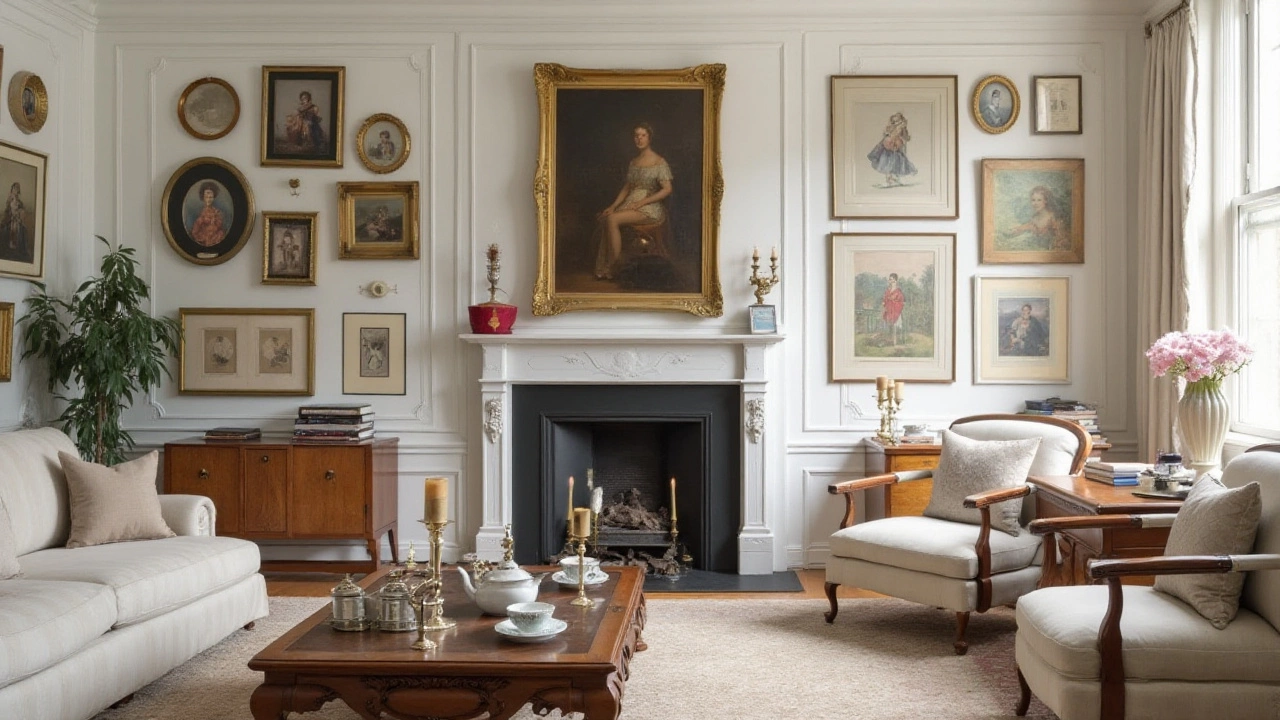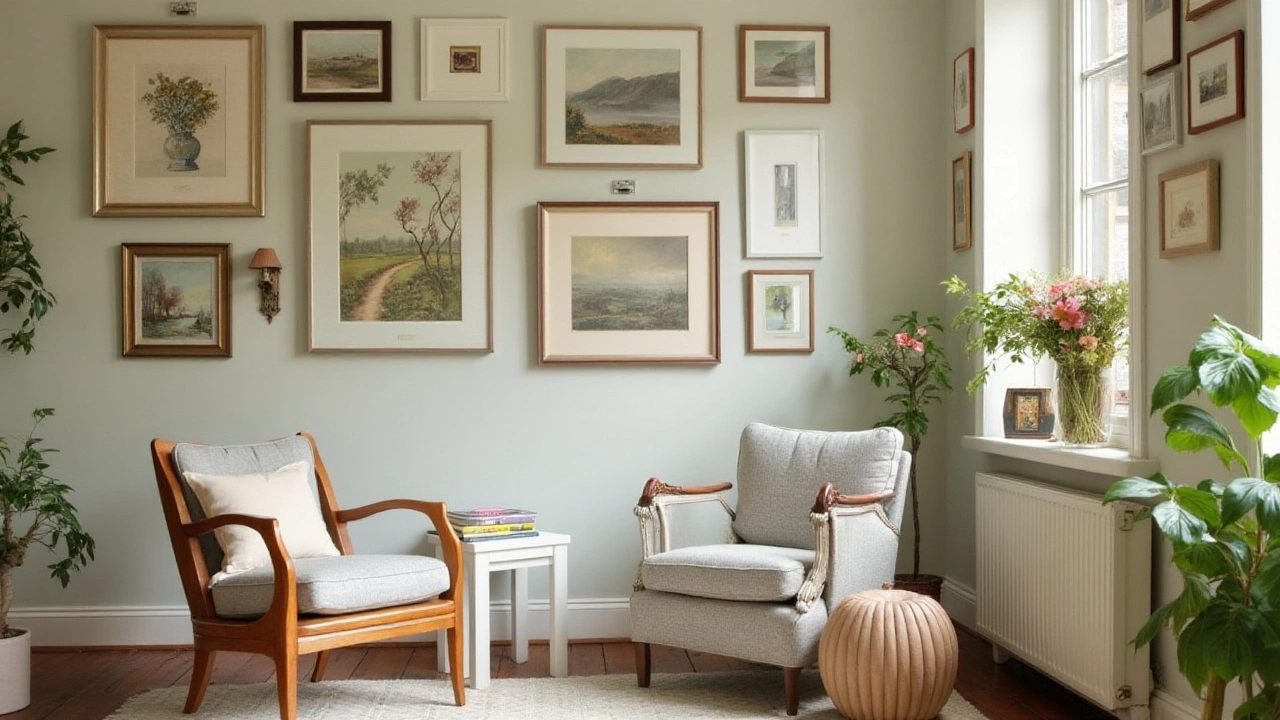Finding the Balance: Art on Your Walls

Decorating your walls with art can transform any space, infusing it with personality and flair. But how much art is too much? This is a question many art lovers grapple with, torn between a desire for self-expression and the quest for a tranquil environment.
Choosing the right amount of art involves more than just filling a blank wall. It's about creating harmony without overwhelming the senses. Whether you're a seasoned collector or a novice art enthusiast, finding the perfect balance is key. Let's explore some tips and tricks to turn your walls into a canvas that tells a beautiful story while maintaining the harmony of your space.
The Art of Balance
Striking the right balance with wall art is a bit like crafting a symphony. Each piece plays a distinct role, contributing to a cohesive whole but never overshadowing the others. The challenge lies in selecting pieces that not only resonate on their own but also complement each other and the space they inhabit. To begin with, the size of your wall and the room itself is crucial. Larger spaces tend to beckon for substantial artworks or a gallery-style layout, which involves several smaller pieces grouped creatively to create a visual impact.
Consider the colors and themes present in your room. Ideally, interior design should deliver cohesion without creating monotony. The colors in your art should echo tones already present in your decor—perhaps in your cushions, rugs, or curtains. A smart approach is employing the 60-30-10 rule renowned among interior designers: 60% of a room should be one dominant color, 30% a secondary color, and 10% an accent color. Let your art either underscore or contrast these ratios.
"Art washes away from the soul the dust of everyday life," said Pablo Picasso. Art’s ability to transform a space and elevate moods cannot be overstated.Think about variety when mixing and matching. Different mediums—paintings, prints, photographs, or even wall sculptures—can blend together beautifully if thoughtfully curated. If everything is too similar, it can end up feeling static despite the diversity in individual pieces. Sometimes, opposites attract, offering a dynamic play between the contrasts of dark and light, complex and minimal, modern and vintage.
There’s also the psychological perspective to consider; what does each piece make you feel? Studies suggest that artwork depicting nature can reduce stress and increase feelings of well-being, a consideration for those seeking tranquility. On the other hand, bold abstract works might stimulate creativity and dynamic thought, making them a great choice for creative spaces or workplaces within the home. The right art display, aligned with your personal vibes, can profoundly influence the atmosphere and energy flow throughout your living space.

Choosing the Right Pieces
In the journey of personalizing your space with wall art, selecting the right pieces is imperative to achieving a visually pleasing and harmonious atmosphere. The art you choose should resonate with your personal taste, yet align with the style and function of your room. Before you embark on your quest for the perfect wall decor, consider the purpose of the room. For instance, living rooms and dining areas may benefit from bold and striking pieces that spark conversation, while bedrooms might call for more soothing and comforting art to promote relaxation.
A good rule of thumb is to mix and match different styles, textures, and color palettes to create a rich visual tapestry. Pay attention to the scale of the artwork. Larger rooms can handle oversized pieces or groupings of smaller artworks, while tight spaces might benefit from more modest-sized art. Experts often suggest the 'Rule of Three'—grouping art in threes to create asymmetrical balance and visual interest.
Art critic Sarah Collins once remarked, "The right amount of art transforms a room, making it a symphony of artistic delight without chaos."When choosing art, also consider lighting. Lighting can dramatically affect how artwork is perceived. Proper lighting can enhance art pieces, drawing the eye and enhancing colors.
Selecting Art by Mood
The mood art conveys is a substantial consideration. Are you aiming for tranquility, excitement, or perhaps a touch of nostalgia? Cool tones tend to have a calming effect, while warm tones can energize. Abstract art, often energized by vibrant hues and dynamic forms, adds a contemporary touch and can serve as a focal point in a minimalistic setting. Home decor experts believe that art should reflect not only the occupant's style but also the feeling the room intends to evoke. Selecting pieces with thought and care will ensure every glance at your walls is both inspiring and a true reflection of yourself.
Where to Find Art
There are numerous places to discover unique art pieces. Local galleries, craft fairs, and even online platforms offer a treasure trove of options. Many online art vendors, such as Saatchi Art or Society6, provide affordable and accessible art from emerging artists. This not only supports the creative community but allows diverse choices that suit various tastes and budgets. For those seeking something truly personal, commissioning an artist to create a custom piece that aligns with your vision is an option. As the art world becomes increasingly digitized, finding the ideal piece to enhance your interior design has never been easier.
Avoiding Common Pitfalls
While it can be tempting to adorn every inch of wall space with art display after art display, restraint is crucial. Overcrowding can dilute the impact of individual pieces. Allow breathing space between artworks, which will highlight each piece's unique allure. Additionally, avoiding pieces that clash with the room's color scheme or furniture styles will prevent visual clutter and maintain a serene atmosphere. Ultimately, the ideal art collection should be a reflection of personal stories and aesthetics, serving as a dialogue between the art and the space it occupies.

Arranging Art Effectively
Arranging art on your walls can be a deeply personal yet striking way to enhance your home’s aesthetic. But achieving this requires a bit of know-how. One key consideration is to ensure your art placements enhance the room's design without dominating the space. First off, pay close attention to the scale and proportion of the pieces. Larger artworks, for example, often work well as focal points and can anchor a room when placed on major walls or above substantial furniture like sofas or fireplaces. Meanwhile, smaller pieces might be scattered together in a gallery style to create a unified, intentional effect.
The layout also requires careful thought. A popular guideline is to imagine your walls as an invisible grid and place art at eye level, which is usually about 145 to 155 centimeters from the floor. This method provides a sense of cohesion and structure to your display. When hanging multiple pieces, keep them reasonably spaced; too close and the collection can feel cramped, too spread apart and the connection is lost. Remember, each piece should have its own breathing space, something that ensures the eye can comfortably move from one artwork to another. Wall art becomes not only an attraction but also part of a conversation within your space.
Interior design experts often point out the importance of variety in an arrangement. Mixing frame styles, colors, and sizes can add dynamism to your display. Incorporating three-dimensional objects or using shelving as part of your arrangement can break up the predictability of flat images on walls. As Sarah Richardson, a Canadian designer, notes, "A room should never allow the eye to settle in one place. It should smile at you and create fantasy." This integration brings a textured allure and unexpected charm to your home decor strategy.
For those seeking to maximize the impact of their art, creating a home decor plan that aligns with your wall's characteristics is vital. Lighting plays a huge role; artworks can be dramatically enhanced with well-placed lights, emphasizing textures and colors that might not be apparent in ordinary daylight. Consider the use of spotlights or wall-mounted lamps to emphasize key pieces. This doesn’t just illuminate art; it can also set the mood of the room.
If you find yourself overwhelmed by options, start with one statement piece and build around it. This can be a painting, a photograph, or even a sculptural piece that speaks to your style. Expand with art display themes that resonate with you, whether that's abstract, landscape, portraits, or a diverse mix. The outcomes should evoke a sense of satisfaction and reflect your unique tastes, telling a story that is as captivating as it is personal. With these foundational steps, you can arrange art effectively and create a stunning visual narrative on your walls.

Common Mistakes to Avoid
When it comes to displaying wall art, it's easy to make mistakes that can disrupt the desired harmony of your room. One common error is overcrowding. While it can be tempting to showcase all your favorite pieces, too many artworks can create visual chaos. This overwhelm can make a space feel smaller and more cluttered, rather than inviting. To avoid this, prioritize your selections. Think about the story or mood you want the room to convey and choose works that align with this vision. Sometimes, less is more, and a single, larger piece can be more impactful than many smaller ones that fight for attention.
Another pitfall is hanging art at the wrong height. The rule of thumb is that the center of the piece should be at eye level, around 57-60 inches from the floor. This is especially important in rooms where people will be standing or sitting, as it keeps the art accessible and aligned with your line of sight. Ignoring this guideline can result in distorted proportions, making it uncomfortable to appreciate the artworks as intended. If your ceiling is particularly high, you might feel inclined to hang pieces higher. Remember, consistency across your home maintains an aesthetic flow.
Many homeowners overlook the importance of cohesion. Art should not be chosen in isolation; it is part of the overall decor. When selecting art, consider the color palette, style, and theme of the room. Bitonio, a famous interior designer, once said,
"Art should amplify your interior’s hero, not detract from it."Mismatched art styles can disrupt room design, causing a disjointed appearance. It's perfectly okay to mix different styles, but aim for a unifying element, whether it be color, theme, or frame style, to tie everything together.
The improper spacing of art is also a frequent misstep. Space between pieces should be consistent to maintain balance. Too little space can make the arrangement feel overcrowded, while too much can cause disconnection. As a rule, 2-3 inches is recommended between pieces in a gallery wall setting. If mounting pieces differently, more space may be appropriate. This ensures each artwork gets its due attention and the wall doesn’t appear overrun with visual information.
Lastly, not experimenting can be just as problematic as the other mistakes. It's easy to fall into the trap of playing it safe. However, avoiding risk can lead to a lackluster environment. Try different arrangements and see what works for the room’s lighting and furniture. Changing frames or adding a splash of color through artwork can enliven the space. Utilizing technology like virtual art placement apps provides the ability to test arrangements before committing, helping you avoid costly mistakes. Embrace experimentation, but balance it with the core aesthetic of your home.


